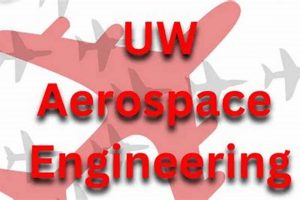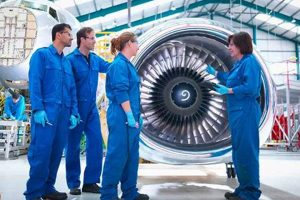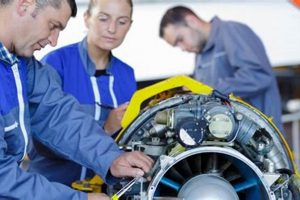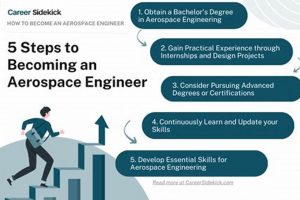The multifaceted nature of flight and space exploration necessitates continuous investigation across a diverse spectrum of scientific and technological domains. These investigations propel advancements in aircraft, spacecraft, and related systems, ultimately expanding the boundaries of what is achievable in the atmosphere and beyond. For instance, the development of new materials with enhanced strength-to-weight ratios directly impacts fuel efficiency and payload capacity.
Sustained focus on these investigative endeavors is critical for maintaining global competitiveness, ensuring national security, and fostering economic growth. Historically, breakthroughs stemming from this activity have led to significant improvements in air travel safety, the creation of entirely new industries centered around space technology, and a deeper understanding of our planet and the universe.
The subsequent sections will delve into specific disciplines where current research efforts are concentrated, showcasing ongoing work in areas such as advanced propulsion systems, autonomous flight control, novel materials science, and the exploration of sustainable aviation practices.
The following suggestions provide guidance for individuals and institutions involved in studies related to the design, development, and operation of vehicles capable of flight within or beyond Earth’s atmosphere.
Tip 1: Prioritize Interdisciplinary Collaboration: Effective problem-solving often requires expertise from multiple fields. Aerospace projects benefit significantly from the integration of knowledge from mechanical, electrical, computer, and materials science. For instance, developing a next-generation drone necessitates collaborative efforts to optimize aerodynamics (mechanical), integrate sensors (electrical), implement autonomous control (computer), and utilize lightweight, durable materials (materials science).
Tip 2: Emphasize Computational Modeling and Simulation: Numerical methods and software tools are vital for analyzing complex systems and predicting performance. Computational Fluid Dynamics (CFD) allows engineers to simulate airflow around aircraft, while finite element analysis (FEA) predicts structural behavior under stress. These techniques reduce the need for expensive and time-consuming physical prototypes.
Tip 3: Focus on Sustainability and Environmental Impact: The aerospace sector must address its contribution to greenhouse gas emissions and noise pollution. Investigation into alternative fuels, electric propulsion, and quieter aircraft designs is crucial for mitigating environmental concerns. For example, exploring the viability of sustainable aviation fuels (SAF) requires understanding their chemical properties, combustion characteristics, and impact on engine performance.
Tip 4: Explore Advanced Materials and Manufacturing Techniques: The pursuit of lighter, stronger, and more heat-resistant materials is essential for improving aircraft and spacecraft performance. Composites, alloys, and nanomaterials offer significant advantages over traditional materials. Additive manufacturing (3D printing) enables the creation of complex geometries and customized components, leading to improved design flexibility and reduced manufacturing costs.
Tip 5: Investigate Autonomy and Artificial Intelligence: Autonomous systems have the potential to revolutionize air traffic management, unmanned aerial vehicle (UAV) operations, and space exploration. Developing robust and reliable algorithms for autonomous navigation, decision-making, and fault diagnosis is critical. This includes research into sensor fusion, machine learning, and artificial intelligence.
Tip 6: Understand Regulatory Frameworks and Safety Standards: Adherence to established rules and guidelines is paramount in the aerospace industry. Researchers must be aware of relevant regulations, safety standards, and certification processes. Collaboration with regulatory agencies and industry stakeholders is essential for ensuring compliance and promoting safety.
Tip 7: Promote Knowledge Sharing and Open Communication: Disseminating research findings through publications, conferences, and open-source platforms accelerates innovation and avoids duplication of effort. Sharing data, models, and code fosters collaboration and allows others to build upon existing work. This approach can dramatically accelerate the pace of discovery and engineering progress.
These suggestions highlight key considerations for driving progress in the field. By embracing collaboration, utilizing advanced tools, and focusing on sustainability, the aerospace engineering community can develop innovative solutions that benefit society and expand the boundaries of exploration.
The subsequent section will provide a detailed summary.
1. Aerodynamics
Aerodynamics forms a cornerstone of aerospace engineering, dictating how aircraft and spacecraft interact with the surrounding air or rarefied atmospheres. Its relevance stems from its direct influence on lift, drag, stability, and overall flight performance, thereby defining operational capabilities and limitations. Understanding and manipulating airflow are crucial for efficient and safe flight across various speed regimes and environmental conditions.
- Computational Fluid Dynamics (CFD)
CFD employs numerical methods to simulate fluid flow around complex geometries. This enables engineers to analyze aerodynamic performance, optimize designs, and predict behavior under different conditions. For example, CFD is instrumental in designing airfoils for increased lift and reduced drag on commercial airliners or simulating hypersonic flow around reentry vehicles to manage heat loads.
- Wind Tunnel Testing
Physical wind tunnels provide a controlled environment to experimentally validate aerodynamic predictions and explore phenomena that are difficult to model computationally. By subjecting scaled models to controlled airflow, engineers can measure forces, visualize flow patterns, and assess stability characteristics. Wind tunnel data is crucial for refining designs and ensuring the safety of aircraft and spacecraft.
- Aerodynamic Shape Optimization
This involves employing mathematical algorithms to iteratively modify the shape of an aircraft or spacecraft component to achieve specific aerodynamic goals, such as minimizing drag or maximizing lift-to-drag ratio. Shape optimization is used extensively in the design of wings, fuselages, and control surfaces, leading to improved fuel efficiency and performance.
- Hypersonic Aerodynamics
This branch focuses on the study of airflow at speeds exceeding Mach 5. At these velocities, complex phenomena such as shock waves, high-temperature effects, and chemical reactions become significant. Hypersonic aerodynamics is critical for designing vehicles capable of atmospheric reentry, scramjet propulsion, and high-speed flight.
These facets demonstrate the pivotal role aerodynamics plays in advancements within the broader field. Ongoing investigations in each of these areas contribute to improved aircraft designs, enhanced performance, and the development of new aerospace technologies. The continuous refinement of aerodynamic principles and techniques remains essential for pushing the boundaries of flight and space exploration.
2. Propulsion
Propulsion represents a critical domain within studies focused on flight and space systems, enabling aircraft and spacecraft to overcome gravity and atmospheric drag. Advances in this area directly translate to increased payload capacity, higher speeds, and expanded mission profiles, fundamentally shaping the capabilities of vehicles operating both within and beyond Earth’s atmosphere.
- Gas Turbine Engines
Gas turbine engines, prevalent in commercial aviation, are subject to ongoing investigation aimed at improving fuel efficiency, reducing emissions, and enhancing reliability. Efforts are focused on advanced compressor and turbine designs, improved combustion technologies, and the integration of novel materials. For example, research into ceramic matrix composites for turbine blades enables higher operating temperatures, leading to increased engine performance and reduced fuel consumption.
- Rocket Propulsion
Rocket propulsion systems are essential for space launch and orbital maneuvers. Studies in this field encompass both chemical rockets, utilizing the combustion of propellants, and electric propulsion, employing electromagnetic forces to accelerate ionized gases. Development of high-performance propellants, advanced nozzle designs, and efficient electric thrusters are key areas of investigation. Ion propulsion systems, for instance, offer high specific impulse, enabling long-duration space missions.
- Hypersonic Propulsion
Hypersonic propulsion addresses the challenges of powering vehicles at speeds exceeding Mach 5. Scramjets (supersonic combustion ramjets) and ramjets are being explored as potential solutions for achieving sustained hypersonic flight. This investigation necessitates a deep understanding of high-temperature gas dynamics, combustion chemistry, and materials science. The development of reliable and efficient hypersonic propulsion systems is critical for future high-speed transport and access to space.
- Alternative Propulsion Concepts
Beyond conventional propulsion systems, studies are exploring innovative concepts such as pulse detonation engines, rotating detonation engines, and hybrid propulsion systems. These approaches offer the potential for improved performance, reduced emissions, or increased operational flexibility. For example, research into pulse detonation engines seeks to harness the energy of controlled detonations to generate thrust, potentially leading to more efficient and compact propulsion systems.
These facets are interconnected and represent crucial lines of inquiry within the broader scope. The continuous pursuit of advancements in these areas drives progress in aerospace engineering, facilitating more efficient, sustainable, and capable flight and space systems. The development of novel propulsion technologies remains a central focus for enabling future aerospace endeavors.
3. Materials
The selection and application of materials are inextricably linked to progress in aerospace engineering. Performance demands related to weight reduction, high-temperature resistance, and structural integrity directly influence materials research and development. Advancements in materials science directly enable improvements in aircraft speed, fuel efficiency, and mission capabilities. For example, the transition from aluminum alloys to carbon fiber composites in aircraft structures has resulted in significant weight savings, leading to improved fuel economy and increased range. Without suitable materials, the realization of advanced designs and ambitious space missions would be impossible.
The interplay between materials science and design extends to specialized applications. Thermal protection systems for spacecraft re-entering Earth’s atmosphere rely on advanced ceramics and ablative materials to withstand extreme heat fluxes. Similarly, high-temperature alloys are crucial for turbine blades in jet engines, allowing them to operate at temperatures exceeding the melting point of conventional metals. The development of self-healing materials and lightweight structural components further contributes to enhanced safety and reduced maintenance requirements in aerospace applications. Therefore, ongoing studies in materials science are not merely academic exercises; they are critical for the practical advancement of aerospace technologies.
The pursuit of novel materials and processing techniques remains a central focus within the aerospace field. Nanomaterials, shape-memory alloys, and advanced composites offer the potential for revolutionary improvements in performance and functionality. However, challenges related to cost, manufacturability, and long-term durability must be addressed before these materials can be widely adopted. Overcoming these obstacles is essential for unlocking the full potential of advanced materials and enabling the next generation of aerospace vehicles.
4. Structures
The integrity of airframes and spacecraft hinges on sound structural design and analysis, a fundamental aspect of investigation within the broader scope of flight and space systems. Structural failures can lead to catastrophic consequences; therefore, understanding the behavior of aircraft and spacecraft structures under various loading conditions is of paramount importance. The investigation encompasses not only the design and analysis of primary structural components like wings, fuselages, and control surfaces but also the assessment of secondary structures and internal support systems.
One critical investigative focus revolves around finite element analysis (FEA), a computational method used to predict the stress, strain, and deformation of complex structural geometries. FEA allows engineers to simulate the effects of aerodynamic loads, thermal stresses, and vibrations on airframes and spacecraft components. For example, FEA is routinely employed in the design of aircraft wings to ensure they can withstand the bending moments and shear forces experienced during flight. Furthermore, structural health monitoring (SHM) systems, incorporating sensors embedded within the structure, provide real-time information on its condition, enabling proactive maintenance and preventing potential failures. The application of SHM is particularly relevant in aging aircraft fleets, where fatigue and corrosion can compromise structural integrity. The use of lightweight composite materials has significantly advanced structural design, requiring advanced techniques for analyzing their unique properties and failure modes.
Structural investigations are continuously evolving to meet the demands of new aerospace technologies. Areas such as aeroelasticity, which examines the interaction between aerodynamic forces and structural deformation, are vital for high-speed aircraft design. Moreover, understanding the impact resistance of composite structures is crucial for enhancing aircraft safety and survivability. Continued progress in this field is essential for ensuring the reliability, safety, and performance of next-generation aircraft and spacecraft, thereby driving innovation and enabling new capabilities in flight and space exploration.
5. Control Systems
The effective management of aircraft and spacecraft necessitates sophisticated control systems, integral to studies related to advancements in flight and space systems. Control systems directly influence stability, maneuverability, and overall mission success. Without precise control, aerospace vehicles are susceptible to instability, inefficient operation, and even catastrophic failure. Consequently, the development and refinement of these systems are paramount in advancing capabilities across diverse aerospace applications.
Consider the application of control systems in autonomous flight. Modern drones, for instance, rely on advanced algorithms to maintain stable flight, navigate complex environments, and avoid obstacles. These algorithms process data from various sensors, including GPS, inertial measurement units (IMUs), and cameras, to make real-time adjustments to control surfaces and engine thrust. In spacecraft, attitude control systems are essential for maintaining proper orientation in space, enabling precise pointing of instruments and antennas. These systems utilize reaction wheels, thrusters, and magnetic torquers to counteract external disturbances and achieve desired pointing accuracy. The design of robust control systems that can operate reliably in the harsh conditions of space is a significant area of ongoing research.
Challenges in control systems investigation include dealing with uncertainty, nonlinearity, and time delays. Aerospace vehicles often operate in environments where conditions can change rapidly and unpredictably. Furthermore, the dynamics of aircraft and spacecraft can be highly nonlinear, making it difficult to design controllers that provide satisfactory performance across a wide range of operating conditions. Time delays in sensor measurements and actuator responses can also degrade control performance and potentially lead to instability. Overcoming these challenges requires the development of advanced control techniques, such as adaptive control, robust control, and model predictive control. These control methodologies enable aerospace vehicles to operate safely and effectively in complex and uncertain environments, thereby broadening the scope of exploration and application of aerospace technologies.
6. Avionics
Avionics, the integration of electronic systems within aircraft and spacecraft, constitutes a critical intersection of engineering disciplines. It is fundamental to the functionality, safety, and performance of modern aerospace vehicles, demanding continuous refinement through focused investigative activities.
- Flight Control Systems
Flight control systems, encompassing autopilots and fly-by-wire technologies, rely on sophisticated sensors, actuators, and algorithms to maintain stability and execute pilot commands. For instance, the development of fault-tolerant flight control systems, capable of handling sensor failures or actuator malfunctions, is essential for ensuring the safety of commercial airliners. These systems require ongoing investigation into sensor fusion, redundancy management, and control law design.
- Navigation and Guidance Systems
Navigation and guidance systems utilize GPS, inertial navigation, and other sensors to determine the position and orientation of an aircraft or spacecraft. These systems are critical for autonomous navigation, precision landing, and accurate trajectory control. Ongoing research focuses on improving the accuracy and reliability of navigation systems in challenging environments, such as GPS-denied areas or near celestial bodies. The integration of advanced sensor technologies, such as lidar and radar, further enhances navigation capabilities.
- Communication Systems
Communication systems enable the exchange of data and voice between aircraft or spacecraft and ground stations, satellites, or other vehicles. These systems are essential for air traffic control, mission telemetry, and emergency communication. Investigation into advanced communication technologies, such as satellite communication and secure data links, is crucial for ensuring reliable and secure communication in aerospace applications. The use of software-defined radios allows for flexible and adaptable communication systems that can be reconfigured to meet changing mission requirements.
- Electronic Warfare Systems
Electronic warfare systems are employed in military aircraft to detect, identify, and counter enemy electronic threats. These systems utilize radar, electronic surveillance, and jamming techniques to protect aircraft from missile attacks and other electronic warfare threats. Research in this area focuses on developing advanced radar technologies, electronic countermeasures, and signal processing algorithms. The integration of artificial intelligence and machine learning into electronic warfare systems enables them to adapt to evolving threats and operate autonomously.
The aforementioned facets highlight the diverse and interdisciplinary nature. Advancements in avionics directly impact the safety, efficiency, and capabilities of both civilian and military aerospace platforms. Continued investigation is essential for maintaining technological leadership and enabling new frontiers in flight and space exploration. The synergy between avionics and other areas of aerospace engineering drives innovation and expands the boundaries of what is achievable in the air and beyond.
7. Space Exploration
Space exploration serves as a primary driver and beneficiary of investigative activities across the discipline of aerospace engineering. The ambitious goals associated with venturing beyond Earth’s atmosphere necessitate constant innovation and refinement in areas such as propulsion, materials science, and avionics. For example, the development of advanced rocket engines capable of delivering heavier payloads to distant destinations directly supports missions to Mars and other celestial bodies. This, in turn, demands the creation of heat shields capable of withstanding extreme temperatures during atmospheric reentry, pushing the boundaries of materials science. Consequently, each objective within space exploration creates a demand for further studies in various fields.
The synergistic relationship between space exploration and the advancement of aerospace engineering is further exemplified by the development of autonomous systems for spacecraft. Missions to remote locations require spacecraft to operate independently, navigating vast distances and performing complex tasks without real-time human intervention. This necessitates the creation of sophisticated control systems and artificial intelligence algorithms, driving innovation in areas such as sensor fusion, path planning, and fault diagnosis. The success of missions like the Mars rovers relies heavily on these advancements, demonstrating the practical application of investigations within the discipline.
The pursuit of space exploration continues to drive progress in the field, presenting unique challenges that stimulate breakthroughs in technology and scientific understanding. While the costs and risks associated with space missions are significant, the potential rewards, including scientific discoveries, technological advancements, and the expansion of human knowledge, justify the continued investment in investigation and development. A deeper understanding of this dynamic is crucial for guiding future efforts and maximizing the benefits of space exploration for society.
Frequently Asked Questions
The subsequent questions address common inquiries and misconceptions concerning investigative activities within the field.
Question 1: What fundamental scientific disciplines are vital to studies in aerospace engineering?
Aerodynamics, thermodynamics, materials science, structural mechanics, and control theory form the foundational knowledge base essential for effective investigation. A strong understanding of these disciplines is crucial for analyzing and designing aerospace vehicles and systems.
Question 2: How do computational tools impact research efforts in this field?
Computational Fluid Dynamics (CFD) and Finite Element Analysis (FEA) are indispensable tools for simulating complex phenomena and optimizing designs. These methods reduce the need for costly physical prototypes and enable engineers to explore a wider range of design possibilities.
Question 3: What role does experimental testing play alongside computer simulations?
Wind tunnels, flight tests, and materials testing are essential for validating computational models and assessing the performance of aerospace systems in real-world conditions. Experimental data provides crucial feedback for refining designs and ensuring safety.
Question 4: Why is the development of new materials a constant focus of investigative effort?
The pursuit of lighter, stronger, and more heat-resistant materials is driven by the need to improve aircraft performance, reduce fuel consumption, and enable missions to extreme environments. Advanced materials enable designs and capabilities that are otherwise unattainable.
Question 5: How does environmental sustainability factor into the ongoing progression of activities in aerospace engineering?
The environmental impact of air travel and space exploration is a growing concern. Investigation into alternative fuels, electric propulsion, and noise reduction technologies is essential for mitigating the environmental footprint of the aerospace industry.
Question 6: What career paths are typically pursued by individuals involved in this investigative pursuit?
Graduates with expertise in this domain can pursue careers in aircraft design, spacecraft engineering, propulsion systems, avionics, and related fields. Opportunities exist in government agencies, aerospace companies, and research institutions.
These responses provide a concise overview of key considerations. Continued investigation and understanding of these aspects are essential for sustained advancement.
The final section will offer a conclusion summarizing key points and future directions.
Conclusion
The presented exploration of research areas in aerospace engineering has underscored the breadth and depth of investigation required to sustain progress in this critical field. From aerodynamics and propulsion to materials science, structures, control systems, avionics, and space exploration, each area demands continuous innovation to meet the evolving challenges of flight and space travel. The integration of computational tools, experimental validation, and a focus on sustainability are essential for driving meaningful advancements.
The future of aerospace engineering hinges on a commitment to rigorous studies across these diverse disciplines. Continued investment in investigation, education, and collaboration will be crucial for unlocking new possibilities, ensuring national security, and expanding humanity’s reach beyond Earth. The collective dedication of researchers, engineers, and policymakers will shape the trajectory of aerospace innovation for generations to come.


![Best Aerospace Engineering Colleges in Kentucky [Ranked] Innovating the Future of Flight with Reliable Aviation Solutions Best Aerospace Engineering Colleges in Kentucky [Ranked] | Innovating the Future of Flight with Reliable Aviation Solutions](https://mixaerospace.com/wp-content/uploads/2025/12/th-760-300x200.jpg)




